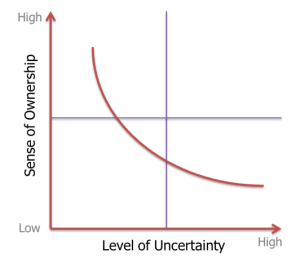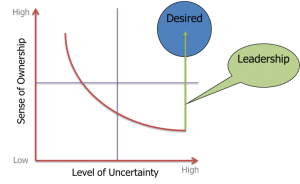In one of my earlier blogs, I had written about some of the thoughts that plague a manager’s mind (refer https://pm-powerconsulting.com/blog/thoughts-plague-managers-mind/). Top of the list was about the ability to make commitments and deliver on them in the face of uncertainty. I thought I will delve into that challenge a bit more and see how managers can handle the uncertainties.
In today’s digital age projects, uncertainty is the norm. Even the customer does not seem to know the requirements; and you are building the software on the shifting sands of today’s technology; not to mention the pressure to deliver faster! So, what’s the true challenge? It is in your mind first – it plays tricks on you! See the following graph that I call Uncertainty-Ownership paradox:
It is human nature though, isn’t it? It is difficult to take ownership when uncertainty levels are high. Here is the paradox – you need high sense of ownership when uncertainty is high and you do not need as much ownership when uncertainty is relatively low! Just the opposite of human nature! What it takes is genuine leadership from the manager to have the desired level of ownership in spite of the uncertainty – it comes down to being aware of one’s thoughts & emotions and having the courage to take ownership!
Three things happen when you take ‘Total Ownership’:
- You are energized – Feeling of ownership is the source of energy in the face of uncertainty. Keyword is ‘feeling’ more than just ‘thinking’ about ownership logically!
- Visible Ownership will inspire your team to step up – you cannot achieve much all by yourself! All fibres in your body need to radiate ownership for team to sense!
- Demonstrated Ownership will persuade your Management & Customer to help you handle the uncertainties.
A practical question arises after one chooses the mindset of total ownership – what do I DO? Here is an effective approach that I have seen managers take to tackle uncertainty in agile projects.
Firstly, identify the sources of uncertainty. Uncertainty in digital age projects could be in some of the following forms:
- Ambiguous/Complex Requirements
- Dependencies
- External interfaces
- Assumptions
- New technology
Secondly, locate the time in the project lifecycle when these uncertainties will resolve themselves.
Thirdly, proactively find ways to bring them forward in the timeline. This is where the manager needs to uses his leadership skills to influence customer, team, management, internal & external suppliers to enable resolving these as soon as possible. Examples: Need to bring forward the time when real-life test data will be available to enable valid tests sooner; Need to get higher capacity servers sooner to enable testing for higher volumes to validate architecture; Need to invest in an external consultant to enable faster and better adoption of new technology; Need to influence another team’s timeline to get the component that you need to integrate; Need to get the right kind of users to the sprint review for acceptance of ambiguous requirements.
In summary, manager with ownership takes action – necessary to tackle uncertainties sooner! Such managers do not take ‘not possible’ for an answer! They are persistent. Action would then improve team’s belief, stakeholders’ belief and manager’s own belief!
How have you tackled uncertainty in your projects? Any specific strategies? Would be happy to hear from you.



